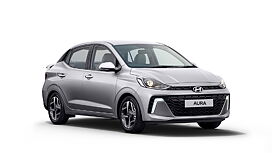What is it?
It’s been three years since the Hyundai Aura made its debut in the Indian market. It evolved as the elongated version of the Grand i10 Nios and now, Hyundai has given this compact sedan its first-ever update in the form of a facelift. What’s changed and what’s now? Let’s take a closer look.

The changes to the exterior styling are subtle and most of them have been made to the facade. The 2023 Aura now gets revised bumpers with a larger and wider front grille with a gloss black mesh design. The LED DRLs too, have now been repositioned from the grille into the bumper replacing the circular fog lamps. And that’s pretty much all the changes the new Aura gets. The side profile and dimensions are unaltered and the 15-inch alloy wheels continue with the same design. The split tail lamps are adjoined by a chrome stripe and the ‘Aura’ lettering is affixed at the centre.

How is it on the inside?
Inside, the overall layout and design of the cabin and the dashboard remain unchanged. The two-tone black and grey theme has been carried forward and the dashboard gets a brown honeycomb-like pattern at the centre. The front seats continue to have fixed headrests and the upholstery is grey in shade and a mix of fabric and leatherette material.

In the second row, the occupants get adequate back and thigh support along with AC vents, door pockets, and a centre armrest with cupholders. Since the dimensions remain similar to the earlier model, the overall space on offer is identical and seats two occupants comfortably and although it has a flat floor, taking a third passenger will be a squeeze due to limited shoulder support.
What’s on the feature list?
Being a Hyundai, the Aura was always a well-equipped sedan with plenty of comfort and safety features. Now, with the facelift, the list sees a revision with a bunch of new features being added to the mix. The Aura now gets footwell ambient lighting a wireless charging pad that sources its power from the 12-volt socket.

Other inclusions are cruise control, a Type-C fast charging port and a revised design for the analogue instrument cluster which repositioned MID screen looks as compared to the older unit. It also ranks high on safety with a tyre pressure monitor and four airbags being offered as standard across the range and six airbags for the range-topping SX (O) variant.

Besides this, the Aura continues to be equipped with features such as an eight-inch touchscreen infotainment system with wired Apple CarPlay and Android Auto, rear aircon vents, a cooled glovebox, automatic climate control, and a height-adjustable driver seat.
What’s under the hood?
Gone are the 1.0-litre turbo-petrol and 1.2-litre diesel engines that were previously offered with the outgoing version of the Aura. Instead, the compact sedan is now only offered with a single petrol engine along with a CNG alternative.

The 1.2-litre naturally-aspirated motor in its petrol guise puts out 82bhp and 114Nm of torque and comes mated to a five-speed manual and an AMT unit. Meanwhile, the same motor in its CNG version gets a lower output of 68bhp and 95Nm of peak torque. This, however, is offered only with a manual transmission.
What about its pricing and rivals?
The new Hyundai Aura is available in four variants – E, S, SX, and SX (O). With a premium of Rs 10,000 to Rs 30,000, the new Aura now has a starting price of Rs 6.30 lakh (ex-showroom). Meanwhile, the CNG version is offered only in S and SX trims that are priced at Rs 8.10 lakh and Rs 8.87 lakh, respectively.

As for its rivals, the Aura continues its competition with the likes of the Maruti Suzuki Dzire, Honda Amaze, and Tata Tigor. While the Amaze is presently the most expensive sedan in the segment with prices ranging from Rs 6.89 lakh to Rs 9.48 lakh, the Dzire and the Tigor have marginally lower starting prices of Rs 6.24 lakh and Rs 6.10 lakh, respectively.

























